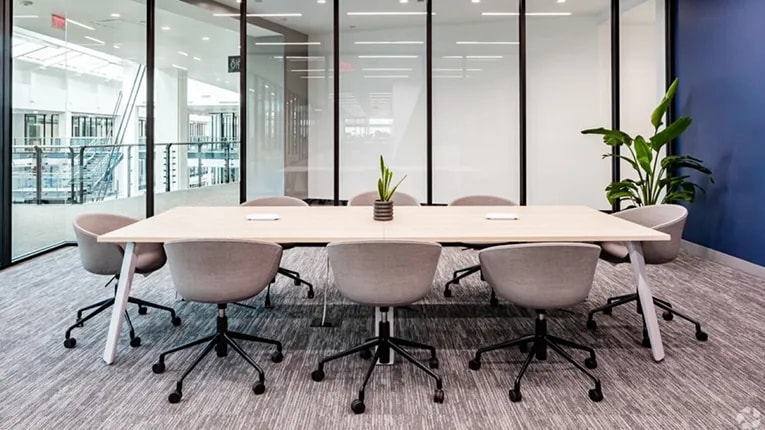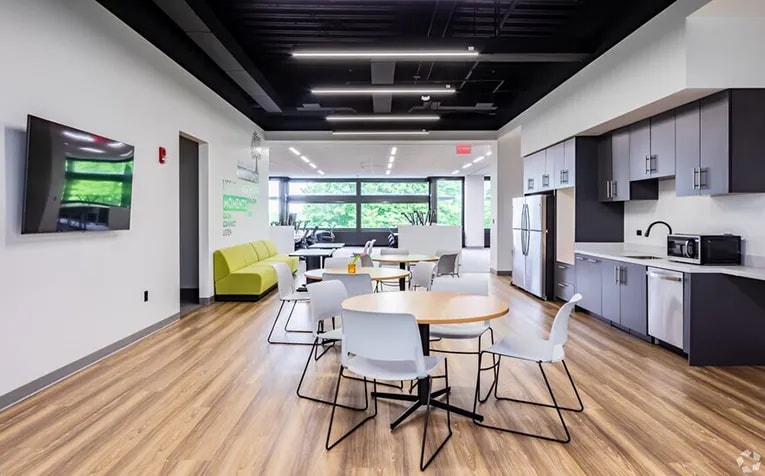Spec Suites: A Powerful Tool in the Battle To Fill Office Space

Uncertainty around a potential recession and office use policies has left business owners rethinking their office strategies. While some are downsizing or renewing short-term leases, others are choosing prebuilt spec suites. Brokers note that current market conditions are making spec suites an especially appealing option.
What is a Spec Suite?
A spec suite - short for speculative suite - is a newly constructed office suite built by a landlord prior to a tenant signing a lease. The suite is considered speculative because the landlord is gambling on the premise that the size, number, layout, and design of the office suites they constructed and paid for will fit the needs of a future tenant.
If the space is not leased, a landlord could have potentially misallocated their capital. But this risk can be mitigated by developing a flexible spec suite strategy that allows for suites of varying sizes across full or partial floors.
It is important to note that spec suites are not executive suites or coworking spaces that are shared by multiple companies. Spec suites are dedicated offices leased directly from landlords that give tenants exclusive use of and full control over their suites. They differ from typical office suites, which often require tenant-led office space construction and custom design.
Origins of Spec Suites
Larry Fitzgerald, executive managing director at Newmark in northern Virginia, explained that typical spec suite tenants are smaller companies that "don't have real estate departments," leaving no one focused on lease expiration dates. He began receiving calls from executive assistants who would say, "Our lease expires in six weeks and we need a space. Do you have anything that's ready to go?"
"After you have that conversation a number of times and you relay that information to landlords, it starts to resonate with them," Fitzgerald continued. As a result, landlords began building spec suites to accommodate last-minute tenants, and today, it’s common for office buildings to offer spec suites for lease.
Why Tenants Like Spec Suites
According to Fitzgerald, spec suites are appealing because most tenants have difficulty visualizing an unfinished space and may lack the time, resources, or desire to manage a full design and construction process on top of a move. Choosing a spec suite can simplify decisions and streamline costs, influencing the overall cost to lease office space.
Grant Pruitt, president of Whitebox Real Estate, agreed: “When you walk through with a tenant, it’s easier for them to visualize how their office will look and function if the suite is already built out.” Larger corporate tenants may have teams to design custom spaces, but smaller companies moving to a new office after many years often need a ready-to-go setup.
Professional services firms, according to Pruitt, tend to favor spec suites, while tech and marketing companies may look for more industrial, open-ceiling styles. For creative firms, spec suites that use second-generation spaces with exposed ceilings and floors can provide that desired edgy look with quick occupancy.
Sizes, Components, and Finishes
Spec suites are generally small, from 1,500 to 5,000 square feet, and designed for broad appeal, said Fitzgerald. "You don't want to build something so specialized that most companies or tenants can't use it." Balancing the cost to build office space with versatility, spec suites usually include a kitchen or pantry, conference rooms, private offices, and open areas. Pruitt added that higher-end finishes, like Herculite glass and carpet squares, are also typical.
Some interior build-out costs, like lighting, HVAC, and finishes, may qualify for tax savings under qualified improvement property rules.

Configuring Layouts
Determining the layout of individual suites is one puzzle, but another is deciding the size and number of suites to build. "If I have a landlord that says, 'What should I do with this 10,000 square-foot floor?' I would say, carve that up into three or four suites of differing sizes so that when a prospective tenant comes in, something will appeal to them," Fitzgerald said.
This approach provides flexibility and efficiency, offering a shorter timeline for leasing office space by presenting tenants with move-in-ready options. Fitzgerald likened it to the Goldilocks theory: “That one’s a little too small, and that one’s a little too big, but this one right here is perfect.”
He emphasized that whether small or large, each suite should include essentials like work rooms, conference rooms, a kitchen, a few offices, and open areas to appeal to a wide market. “About 50% of the time, someone wants to tweak a spec suite, and 50% of the time, they take it as is,” Fitzgerald added.
How Many Suites Per Building?
Fitzgerald advises landlords to leave some floors unencumbered for larger tenants, as "big companies tend to start shopping very early," allowing time for a custom build-out. For the remaining floors, he recommends dividing vacant space into three to five suites of different sizes. This approach, Fitzgerald explained, follows the “Goldilocks” principle: “One’s a little too small, one’s a little too big, but this one is perfect.” Landlords benefit from slightly higher rates due to the “ready-to-go” factor.
Furniture and Cabling
Occasionally spec suites are furnished, and Fitzgerald said "it's typically the aggressive landlord that wants to spend that extra money to furnish their spec suites so they're that much closer to being ready to go. But it's expensive and you're taking the risk that the tenant won't want or won't need that furniture because they're coming in with their own stuff."
"But I tend to say, if you are willing to furnish it, let's do it, because you're staging, like [you would] a house for sale. You want the space to show well and the prospect to think 'Johnny could go over here, and Mary could sit there.'"
In Dallas, Pruitt said "we've started to see some landlords, and I don't mean a lot, but some landlords provide cabling, which is a true value; that's an expense that a tenant of that size may not be aware of."
Why Landlords Invest in Spec Suites
"I think the way most landlords view it is that by building out a spec suite, it expedites the lease up of that space," Fitzgerald said. He characterizes it as a cost benefit analysis; it costs a little bit more upfront to get the space ready, but "the delivery timeline is that much quicker."
This has become "the go-to strategy now with most landlords," Fitzgerald said. They're building spec suites because they're finding that many tenants don't want to go through the construction process. He added that this is especially true in a market like the one we are in now, where companies are downsizing and there continues to be uncertainty about whether or not employees need to work from the office.
Asked if rising construction costs are deterring tenants from traditional custom build outs, Fitzgerald said, "I don't think the tenants are that mindful or understanding of the costs." Instead, he said they focus on the new condition of the space, the ability to be up and operating in 30 to 60 days, and the opportunity to avoid the brain damage of "designing, building and having somebody on staff coordinate with contractors."
Sunk Costs and Short-Term Leases
Pruitt noted that spec suites are more expensive for landlords to build than preleased, custom-designed office suites. In traditional leases, landlords often share build-out costs through a tenant improvement allowance. With spec suites, landlords cover the entire cost upfront.
“Most landlords view this as a sunk cost,” Fitzgerald said. This upfront investment often means they are open to shorter-term leases of three to five years, with the expectation of renewal for a better return.
However, Fitzgerald added, landlord strategies vary: those focused on occupancy may invest heavily upfront to attract tenants, while entrepreneurial landlords focused on cash flow may opt out of spec suites.
Targeting Spec Suites Exclusively
Despite declining overall demand for office space and very high construction costs, landlords continue to build spec suites, Fitzgerald said. "It's almost like you're at a competitive disadvantage if you have an office building and you don't have spec office suites available."
"I know tenant brokers who look exclusively for spec suites when they're setting up tours because, for whatever reason, their client doesn't have the time, patience or inclination to fool with build outs," he added. "They want to go to ready-to-go suites."
Closing Thoughts
As the office space market continues to evolve, spec suites offer an adaptable, move-in-ready option for companies needing flexibility and efficiency. For businesses seeking streamlined occupancy, lower upfront costs, and spaces that match their operational needs, spec suites present a compelling choice.
If you're ready to explore available offices for lease, including move-in-ready spec suites, browse our current listings to find the perfect fit for your business needs.
